Molti utenti di WordPress preferiscono lavorare sui propri siti web utilizzando un server locale sul proprio computer. In questo modo è possibile lavorare sul sito web in modo privato prima di rendere disponibili le modifiche on line.
Alla fine, dovrete spostarlo su un server live per renderlo accessibile ai visitatori online. Questa transizione è fondamentale per garantire il corretto funzionamento del sito web on line.
Abbiamo lavorato su molti siti web locali, quindi abbiamo dovuto imparare il modo più semplice per trasferire i contenuti a siti web in carne e ossa.
In questo articolo forniremo istruzioni passo passo su come spostare WordPress da un server locale a un sito live.
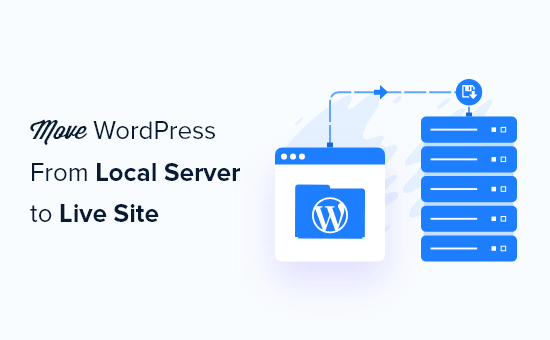
Perché spostare WordPress da un server locale a un sito live?
Creare il vostro blog WordPress su un server locale è un modo sicuro per testare le modifiche apportate al vostro sito web senza influenzare i visitatori.
Una volta perfezionato il sito web, il passo successivo consiste nel passare dal server locale a un sito live.
Vi mostriamo due modi per spostare il vostro sito da un server locale a un sito live.
Il primo metodo utilizza un plugin di migrazione di WordPress ed è consigliato ai principianti.
Nel secondo metodo, vi mostreremo come spostare manualmente WordPress da un server locale a un sito live.
Potete scegliere il metodo più adatto a voi:
Prima di migrare il sito WordPress
Per migrare WordPress da un server locale a un server live è necessario disporre di alcuni elementi.
Innanzitutto, supponiamo che abbiate un sito WordPress in esecuzione su un server locale (chiamato anche localhost) sul vostro computer e che abbiate pieno accesso ad esso.
Successivamente, è necessario disporre di un nome di dominio e di un hosting web.
Abbiamo sentito innumerevoli storie di principianti che hanno iniziato con fornitori di hosting web scadenti o gratuiti e se ne sono pentiti. Secondo la nostra esperienza, la scelta del giusto fornitore di hosting è fondamentale per il successo di qualsiasi sito web.
Per facilitare la vostra decisione, vi consigliamo di utilizzare Bluehost. Si tratta di una società di hosting WordPress ufficialmente raccomandata, che offre agli utenti di WPBeginner uno sconto esclusivo + dominio e SSL gratuiti.
In pratica, potete iniziare a lavorare con soli 1,99 dollari al mese.
Se volete un’ottima alternativa a Bluehost, potete dare un’occhiata a Hostinger. Offre anche uno sconto esclusivo agli utenti di WPBeginner con un nome di dominio gratuito.
Se potete permettervi di pagare un po’ di più, allora date un’occhiata a SiteGround. Hanno anche un’offerta speciale per i lettori di WPBeginner.
Se avete bisogno di aiuto per creare il vostro sito web, seguite la nostra guida passo passo su come creare un sito web.
Infine, è necessario disporre di un programma FTP e sapere come usare l’FTP per caricare il sito del server locale sul sito live.
Siete pronti? Iniziamo la migrazione del vostro sito WordPress.
Video tutorial
Se preferite le istruzioni scritte, continuate a leggere.
Metodo 1: Trasferire WordPress dal server locale al sito live utilizzando un plugin di migrazione (consigliato)
Questo metodo è più semplice e consigliato ai principianti. Utilizzeremo un plugin di migrazione di WordPress per spostare WordPress da localhost a un sito live.
Passo 1: Installare e configurare il plugin Duplicator
Per prima cosa, è necessario installare e attivare il plugin Duplicator sul sito locale. Per maggiori dettagli, consultate la nostra guida passo-passo su come installare un plugin di WordPress.
Suggerimento professionale: Esiste anche una versione pro di Duplicator che offre backup sicuri, archiviazione su cloud, ripristino semplice del sito e altro ancora.
Dopo l’attivazione, è necessario andare alla pagina Duplicator ” Backups e fare clic sul pulsante ‘Create New’.
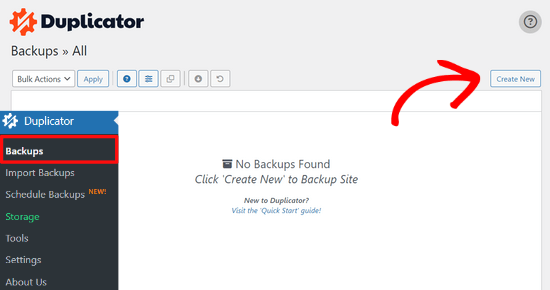
Si accede così a una schermata in cui è possibile assegnare un nome al backup.
Quindi, fare clic sul pulsante “Avanti”.

Duplicator eseguirà ora alcuni test per verificare che tutto sia in ordine.
Se tutti gli elementi sono contrassegnati da “Buono”, cliccate sul pulsante “Costruisci”.

Questo processo può richiedere alcuni minuti, a seconda delle dimensioni del sito web. È necessario lasciare aperta questa scheda fino al completamento.
Una volta terminato, verranno visualizzate le opzioni di download per i pacchetti “Installatore” e “Archivio”. È necessario fare clic sul pulsante “Scarica entrambi i file” per scaricare entrambi i file sul computer.

Il file “Archivio” è una copia completa del vostro sito WordPress. Include tutti i file principali di WordPress, nonché le immagini, i caricamenti, i temi, i plugin e un backup del database di WordPress.
Il file “Installer” è uno script che automatizza l’intero processo di migrazione scompattando il file di archivio contenente il vostro sito web.
Fase 2: Creare un database per il vostro sito web WordPress dal vivo
Prima di eseguire il programma di installazione o di caricare il sito web WordPress da localhost al vostro server di hosting, dovete creare un database MySQL per il vostro nuovo sito web live.
Se avete già creato un database MySQL, potete saltare questo passaggio.
Per creare un database, è necessario visitare la dashboard del cPanel del proprio account di hosting. Quindi, individuate la sezione “Database” e fate clic sull’icona “MySQL Database Wizard”.
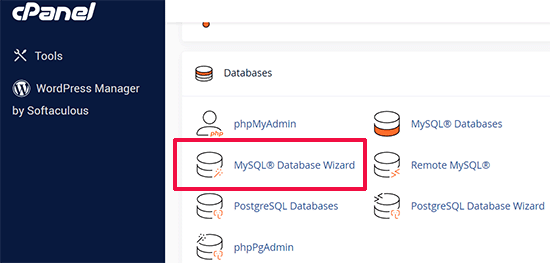
Nella schermata successiva, c’è un campo per creare un nuovo database.
È sufficiente indicare un nome per il database e fare clic sul pulsante “Crea database”.

cPanel creerà ora un nuovo database per voi.
A questo punto, è necessario inserire un nome utente e una password per il nuovo utente e fare clic sul pulsante “Crea utente”.
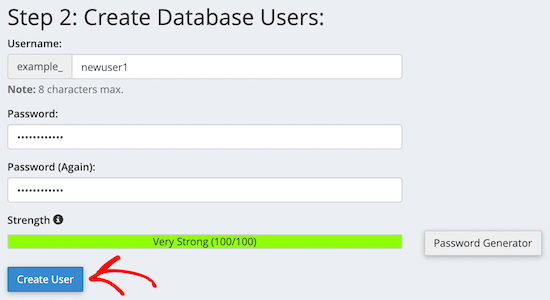
Successivamente, è necessario aggiungere l’utente appena creato al database.
Innanzitutto, fare clic sulla casella di controllo “Tutti i privilegi”.
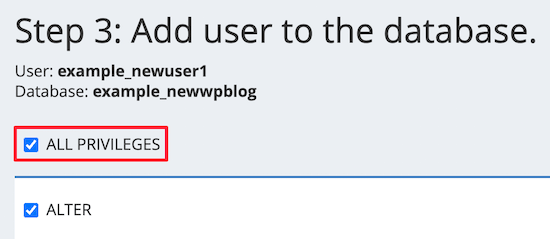
Quindi, scorrere verso il basso e fare clic sul pulsante “Applica modifiche” per salvare le modifiche.
Il database è ora pronto per essere utilizzato con il vostro sito WordPress. Assicuratevi di annotare il nome del database, il nome utente e la password. Queste informazioni vi serviranno nella fase successiva.
Fase 3: caricare i file dal server locale al sito web WordPress dal vivo
Ora è necessario caricare i file dell’archivio e del programma di installazione dal sito locale all’account di hosting.
Per prima cosa, collegatevi al vostro sito live utilizzando un client FTP. Una volta collegati, assicuratevi che la directory principale del vostro sito sia completamente vuota.
Normalmente, la directory principale è la cartella /home/public_html/.
Alcune società di hosting WordPress installano automaticamente WordPress al momento dell’iscrizione. Se sono presenti file di WordPress, è necessario eliminarli.
Successivamente, è possibile caricare i file archive.zip e installer.php da Duplicator nella cartella principale vuota.

Passo 4: esecuzione dello script di migrazione
Dopo aver caricato i file di migrazione, è necessario visitare il seguente URL nel browser:
http://example.com/installer.php
Non dimenticate di sostituire “example.com” con il vostro nome di dominio.
In questo modo si avvia la migrazione guidata di Duplicator.
Il programma di installazione eseguirà alcuni test e inizializzerà lo script.
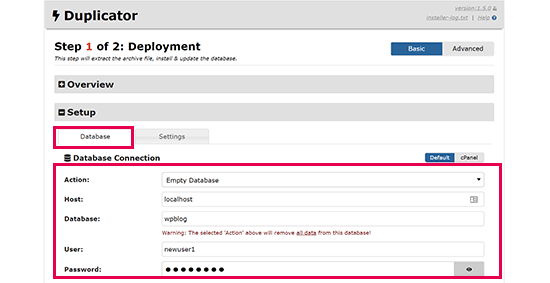
Nella sezione Setup, vi verrà chiesto di inserire l’host MySQL, il nome del database, il nome utente e la password.
L’host sarà probabilmente un host locale. Successivamente, si inseriranno i dettagli del database creato nel passo precedente.
Quindi, fare clic sul pulsante “Convalida” per verificare che i dati inseriti siano corretti.
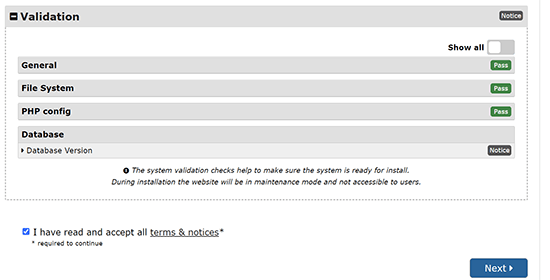
Dopodiché, fare clic sul pulsante “Avanti” per continuare.
Duplicator importerà ora il backup del database di WordPress dall’archivio al nuovo database.
Inoltre, aggiorna gli URL che puntano al sito locale e al nuovo sito live.
A questo punto è possibile fare clic sul pulsante “Admin Login” per accedere all’area di amministrazione di WordPress del sito live.

Una volta effettuato l’accesso al sito live, Duplicator pulirà automaticamente i file di installazione.
È tutto. Avete spostato con successo WordPress dal server locale al vostro sito live.
Metodo 2: Trasferire manualmente WordPress dal server locale al sito live
In questo metodo, vi mostreremo come spostare manualmente WordPress dal server locale al vostro sito live. Sarà utile se il primo metodo non funziona o se preferite farlo manualmente.
Passo 1: Esportare il database locale di WordPress
La prima cosa da fare è esportare il database locale di WordPress. Per farlo, utilizzeremo phpMyAdmin.
Se non lo conoscete, potete dare un’occhiata alla nostra guida alla gestione del database di WordPress con phpMyAdmin.
Basta andare su http://localhost/phpmyadmin/ e cliccare sul database di WordPress. Quindi, fare clic sul pulsante “Esporta” nella barra dei menu in alto.

Nell’opzione “Metodo di esportazione:” si può scegliere “Rapido” o “Personalizzato”. Personalizzato vi fornirà più opzioni per esportare il vostro database.
Tuttavia, si consiglia di scegliere “Rapido” e di fare clic sul pulsante “Vai” per scaricare il database.

Passo 2: caricare i file di WordPress sul sito live
Ora è necessario spostare tutti i file del sito web sul sito live.
Per iniziare, aprite il vostro client FTP e collegatevi al vostro account di hosting web.
Una volta collegati al sito live, assicuratevi di caricare i file nella directory giusta. Ad esempio, se si vuole che il sito sia ospitato su “yoursite.com”, si dovranno caricare tutti i file nella directory public_html.
Ora selezionate i file locali di WordPress e caricateli sul vostro server live.
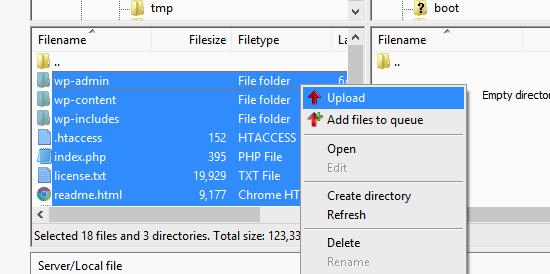
Passo 3: Creare un database MySQL sul sito live
Mentre il client FTP carica i file di WordPress, potete iniziare a importare il database sul server live.
La maggior parte dei fornitori di hosting WordPress offre cPanel per gestire il vostro account, quindi vi mostreremo come creare un database utilizzando cPanel.
Per prima cosa, è necessario accedere alla dashboard di cPanel e fare clic sull’icona “MySQL Database Wizard”, che si trova nella sezione “Database”.

Nella schermata successiva è possibile creare un nuovo database.
È necessario indicare un nome per il database, quindi fare clic su “Crea database”.

cPanel creerà automaticamente un nuovo database.
Successivamente, è necessario inserire un nome utente e una password per il nuovo utente e fare clic su “Crea utente”.
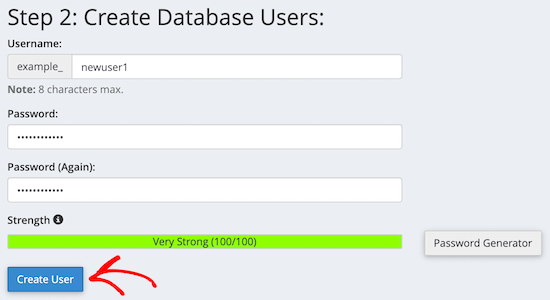
Successivamente, è necessario aggiungere l’utente appena creato al database.
Innanzitutto, selezionare la casella di controllo “Tutti i privilegi”.
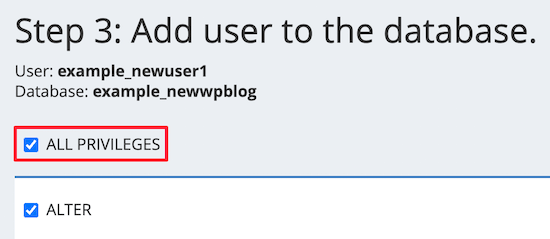
Quindi, scorrere verso il basso e fare clic su “Applica modifiche” per salvare le modifiche.
Avete creato con successo un nuovo database per il vostro sito WordPress live.
Passo 4: Importare il database di WordPress nel sito live
La fase successiva del processo consiste nell’importare il database di WordPress.
Andate nella vostra Bacheca cPanel, scorrete giù fino alla sezione “Database” e fate clic su “phpMyAdmin”.
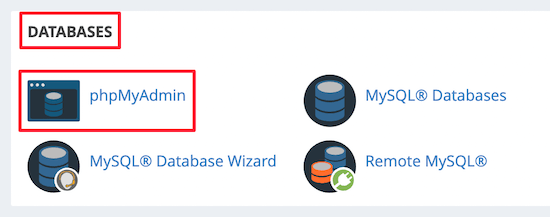
Si accede così a phpMyAdmin, dove si deve fare clic sul database appena creato. phpMyAdmin mostrerà il nuovo database senza tabelle.
Quindi, fare clic sulla scheda “Importa” nel menu superiore. Nella pagina di importazione, fare clic sul pulsante “Scegli file” e selezionare il file del database dal sito locale salvato nel primo passaggio.
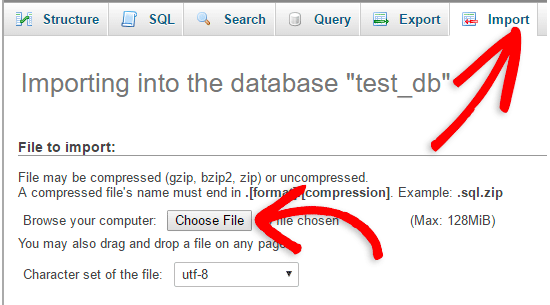
Dopodiché, fare clic sul pulsante “Vai” in fondo alla pagina. Il database verrà importato automaticamente in phpMyadmin.
Passo 5: modificare l’URL del sito
A questo punto, è necessario modificare l’URL del sito nel database in modo che si connetta con il sito WordPress attivo.
In phpMyAdmin, cercate la tabella wp_options nel database che avete appena importato.
Se si è cambiato il prefisso del database, invece di wp_options, potrebbe essere {nuovo_prefisso}_options.
Quindi, fare clic sul pulsante “Sfoglia” accanto a wp_options. Oppure, fate clic sul link nella barra laterale per aprire la pagina con l’elenco dei campi della tabella wp_options.
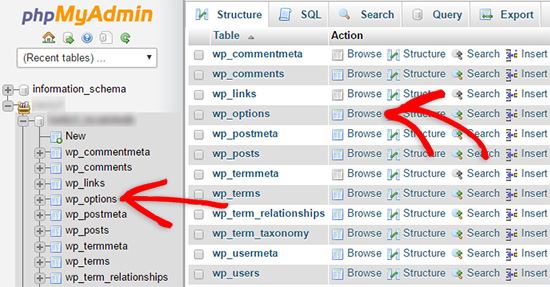
Quindi, nella colonna options_name, occorre cercare l’opzione siteurl.
Quindi, fare clic sull’icona “Modifica”.

Si apre una finestra in cui è possibile modificare il campo.
Nell’input boxed option_value, verrà visualizzato l’URL dell’installazione locale, che sarà qualcosa come http://localhost/test.
In questo campo è necessario inserire l’URL del nuovo sito, ad esempio: https://www.wpbeginner.com.
Quindi, è possibile salvare il campo facendo clic sul pulsante “Vai”.
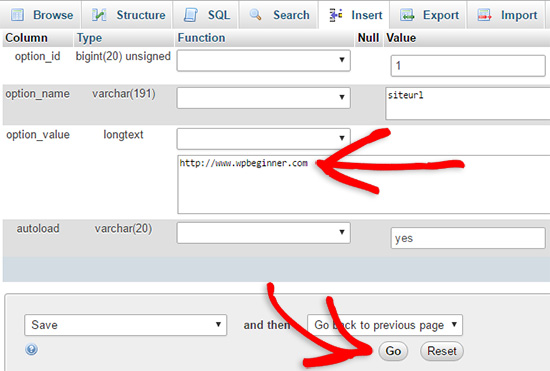
Successivamente, è necessario seguire la stessa procedura descritta sopra per il nome dell’opzione home. Il menu wp_options può essere lungo alcune pagine. Di solito, l’opzione home si trova nella seconda pagina.
Quindi, aggiornare l’URL della home, in modo che sia uguale a quello del sito live.
Passo 6: Configurare il sito live
Ora che avete importato il database e caricato i contenuti, è il momento di configurare WordPress.
A questo punto, il sito dovrebbe mostrare l’errore“Errore nello stabilire una connessione al database“.
Per risolvere il problema, collegarsi al sito web con un client FTP e aprire il file wp-config.php.
Dovrete cercare le seguenti righe di codice:
1 2 3 4 5 6 7 8 9 | // ** MySQL settings - You can get this info from your web host ** ///** The name of the database for WordPress */define( 'DB_NAME', 'database_name_here' );/** MySQL database username */define( 'DB_USER', 'username_here' );/** MySQL database password */define( 'DB_PASSWORD', 'password_here' );/** MySQL hostname */define( 'DB_HOST', 'localhost' ); |
È necessario fornire il nome del database, il nome utente e la password creati in precedenza.
Quindi, salvate il file wp-config.php e caricatelo sul vostro server di hosting WordPress.
Ora, quando si visita il sito web, questo dovrebbe essere attivo.
Dopodiché, è necessario accedere al pannello di amministrazione di WordPress e andare in Impostazioni ” Generale”. Quindi, senza modificare nulla, scorrere fino in fondo e fare clic sul pulsante “Salva modifiche”.
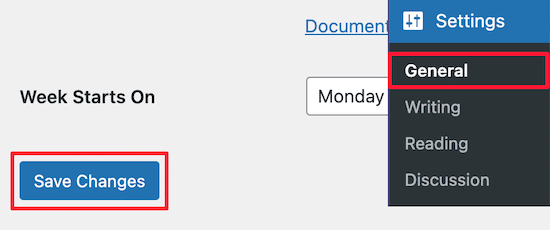
In questo modo ci si assicurerà che l’URL del sito sia corretto ovunque sia necessario.
Una volta fatto, andare su Impostazioni ” Permalinks, quindi scorrere verso il basso e fare clic su “Salva modifiche” per assicurarsi che tutti i link ai post funzionino correttamente.

Passo 7: Correggere le immagini e i link rotti aggiornando i percorsi
Ogni volta che spostate un sito WordPress da un dominio a un altro o da un server locale a un sito live, vi troverete di fronte a collegamenti interrotti e immagini mancanti.
Vi mostriamo due modi per aggiornare gli URL. Potete scegliere quello più adatto a voi.
1. Aggiornare gli URL con il plugin Search & Replace Everything (consigliato)
Il modo più sicuro per correggere questo problema è utilizzare Search & Replace Everything. Si tratta di un potente plugin per WordPress che consente di eseguire facilmente operazioni di aggiornamento di massa sul vostro sito web senza scrivere complesse query al database.
Per prima cosa, è necessario installare e attivare il plugin Search & Replace Everything.
Dopo l’attivazione, andare alla pagina Strumenti ” WP Search & Replace.
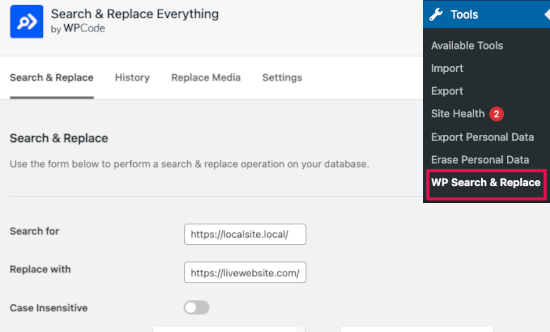
Da qui è necessario inserire l’URL del sito locale nel campo “Cerca” e l’URL del sito live nel campo “Sostituisci con”.
Scorrere un po’ e fare clic su “Seleziona tutto” sotto le tabelle. In questo modo il plugin cercherà il vecchio URL ovunque nel database.

Ora fate clic sul pulsante “Anteprima di ricerca e sostituzione” per continuare.
Il plugin cercherà nel database tutte le istanze del vecchio URL e vedrà l’anteprima dei risultati.
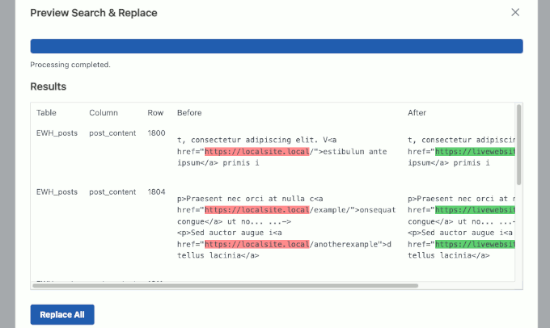
Se tutto sembra a posto, cliccate su “Sostituisci tutto” per salvare le modifiche.
Verrà visualizzata un’attenzione alle modifiche che si stanno apportando. Fare clic su “Sì” per continuare.
Il plugin aggiorna il database e sostituisce gli URL locali con l’URL attuale del sito web.
2. Aggiornare manualmente gli URL (avanzato)
Un altro modo per aggiornare gli URL è utilizzare la seguente query SQL:
1 | UPDATE wp_posts SET post_content = REPLACE(post_content, 'localhost/test/', 'www.yourlivesite.com/'); |
Basta andare su phpMyAdmin, fare clic sul database, quindi cliccare su “SQL” dal menu in alto e aggiungere la query di cui sopra.
Assicurarsi di modificare gli URL del sito locale e del sito live e fare clic sul pulsante “Vai”.
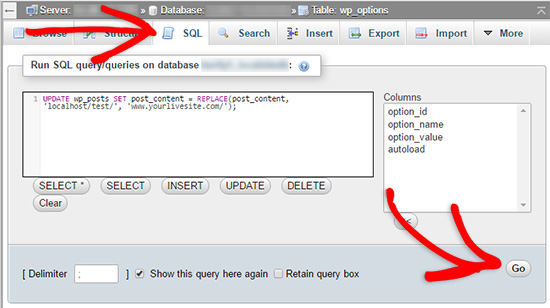
Ecco fatto. Ora avete migrato con successo WordPress dal vostro server locale a un sito live.
Speriamo che il vostro sito web sia attivo e funzionante senza problemi. Se notate degli errori, potete selezionare la nostra guida agli errori comuni di WordPress per aiutarvi nella risoluzione dei problemi.
Speriamo che questo articolo vi abbia aiutato a spostare WordPress da un server locale a un sito live. Potreste anche consultare la nostra guida sullo spostamento di un sito live su un server locale o dare un’occhiata alla lista di controllo definitiva per la migrazione di un sito web per i passaggi pratici della migrazione di WordPress.
Se questo articolo vi è piaciuto, iscrivetevi al nostro canale YouTube per le esercitazioni video su WordPress. Potete trovarci anche su Twitter e Facebook.





david kule
thank you guys!!
i followed the steps it’s working for me
your save my life
WPBeginner Support
You’re welcome
Admin
Sunita
Really Thanks:)…It’s a great tutorial and it’s very helpful to me..
one thing i asked you..can you tell me how to open wp dashboard after this??
WPBeginner Support
You would want to add /wp-admin to the end of your domain and that should bring you to the login page where you would use the same login information as on your local install.
Admin
Sunita
Really Thanks:)…It’s a great tutorial and it’s very helpful to me..
WPBeginner Support
You’re welcome
Admin
gerardo
HI! i have a live site fully operational but on localhost i make a new site, mostly design. If i migrate it using some pluguin like duplicator, the info from the old site would be deleted?
WPBeginner Support
It would not remove your local site but if you’re trying to install it where a site is already installed then you would run into overwriting issues.
Admin
Grace Lee
After moving my website to a live site, will I still be able to edit and make changes to it? Thanks!
WPBeginner Support
Yes, you would be able to
Admin
Ifeanyi
Easy to follow guide. Even easier than some videos i have watched on youtube.
WPBeginner Support
Glad you’ve found our content helpful
Admin
Temidayo Marvel
Great solution to my Problem.
Thanks
is it safe and easy to use premium themes and plugins on the wampsever while testing and setting up the WordPress site locally, or do I need to deploy my themes and plugins after importing the site to a livehost.
WPBeginner Support
You would want to check with the support for the theme and plugins you’re wanting to use for if they work on local sites or not.
Admin
Israel
Thanks for the guide, it really helped!
WPBeginner Support
You’re welcome
Admin
Jason Bar
I got lost on the part “connect to your live site using an FTP client.”
That is completely different tutorial where there is no hyperlink to see it.
WPBeginner Support
We will be sure to work on improving clarity of this in the future, we linked to our guide on FTP at the start of our article, you can find the FTP guide below:
https://www.wpbeginner.com/beginners-guide/how-to-use-ftp-to-upload-files-to-wordpress-for-beginners/
Admin
Jason Bar
Thank you, I missed it.
Janith
Method 1 worked fine afrter few refreshes in the step 2. Thanks
WPBeginner Support
Glad our guide was able to help
Admin
Ashley Davies
Thanks for the article, I have run into a problem doing method 1. In step 4, when I visit the url at mysite/installer.php, I get an error from duplicator as follows:
‘Archive not found! The ‘Required File’ below should be present in the ‘Extraction Path’. The archive file name must be the exact name of the archive file placed in the extraction path character for character.’
Any help with this would be greatly appreciated
WPBeginner Support
You would want to check with your hosting provider that the file is located in the correct location in your files.
Admin
STEPHEN OFORI
Wow… I can believe my eyes. It worked perfectly with the first option. God bless you.
WPBeginner Support
Glad our guide was helpful
Admin
Temitope Durotoye
Thank you so much for this… Really helped me a lot.
WPBeginner Support
You’re welcome, glad our guide was helpful
Admin
Elías Sánchez
I suffer with this kind of stuff, in fact today i spent a lot of hours doing this migration from local to a server.
Reading and following this helped a lot.
Thanks for sharing!
WPBeginner Support
You’re welcome, glad our guide could help with this process
Admin
Yusuf Omotoso
The post is really helpful just like many other posts. Thank you
WPBeginner Support
You’re welcome
Admin
Luz Manalo-Cruz
Hi. I’ve successfully migrated from localhost to livesite! Yay! What now do I do with the localhost?
WPBeginner Support
That would be a personal preference question whether you would like to keep it or remove it.
Admin
Luz Manalo-Cruz
Hi! Using Method 1, all went well until Step 4 – the migration wizard doesn’t launch when I type in example.com/installer.php (I changed example.com to my domain). Instead I get a Page Not Found. I’ve tried this twice now and I get the same Page Not Found screen on Step 4. Am I missing a step?
WPBeginner Support
You may want to ensure you placed the file inside the correct folder, you can check with your hosting provider and they should be able to assist.
Admin
Habibul Islam
Thanks. I have done migration by 1st method.
WPBeginner Support
Glad our guide could assist
Admin
Milutin
If someone has problems on Method 1 Step 4 with cPanel host name (error text: No such file or directory), instead of localhost, try mysql. This step always bugs me off nad frustrates me.
Thanks for the great tutorial! Used it multiple times!
WPBeginner Support
Thanks for sharing what worked for you
Admin
Purushothaman Gempuraj
Thanks. The first Duplicator based method worked for AWS based AMI Linux server 2 which had external database connection as well.
WPBeginner Support
Glad our recommendation worked for you
Admin
Meredith Bashert
I’m still seeing “error establishing a database connection.” I don’t have a domain name set yet (waiting until the site is complete) so I used the domain name that I used to log in to the FTP client as my option value in my wp_options.
WPBeginner Support
For that error, the domain you set is likely correct but you would want to double-check your username and password for your wp-config file
Admin
Husain
Dear WpBeginner team,
In case i already have a website running on my live server (Hosting) and i want to upload a new site on it, so do i need to manually delete all the old files ?
Please advise.
WPBeginner Support
If you are using the manual method from this article you would overwrite the files currently on your hosting rather than deleting them.
Admin
Paul K
Thank you so much for the instructions. The manual way was way simpler and faster than any plugin I tried.
WPBeginner Support
Glad our guide could help
Admin
Rehman Ali
Thanks! Just followed and migrated my site using method 1. Thanks!
WPBeginner Support
You’re welcome, glad our recommended method was able to assist
Admin
Lia
Thank you for that great tutorial! It was really help
WPBeginner Support
You’re welcome, glad our guide was helpful
Admin
JLA
you forgot to include in method the wp-config.php file to edit database connection
WPBeginner Support
As the database is being copied from your local environment it means you will not need to edit the wp-config normally
Admin
Oni
Thank you very much for this update. I really appreciate.
WPBeginner Support
You’re welcome
Admin
Beth
I am completely stuck on Method 1 Step 3 – when i try to connect in FileZilla it keeps saying “Could not connect to server”. Please help!
WPBeginner Support
The most common reason would be your FTP information being incorrect, if you reach out to your hosting provider they should be able to assist.
Admin
Shubham
After exporting my website from local host i couldn’t import it to another wordpress which is live . This was because of file size limit. Any suggestion in this regard.
WPBeginner Support
For that error, you would want to take a look at our guide here:
https://www.wpbeginner.com/wp-tutorials/how-to-increase-the-maximum-file-upload-size-in-wordpress/
Admin
Peter
The Mamp guys have now a publish to live site function in the pro version.
WPBeginner Support
Thanks for sharing that information
Admin
Claudia
Thank you so much for your tutorial. I built the website on localhost, thanks to your tutorial about it. I have a question about this process of going from local to live though.
I currently have a page online and working. I wantred to change it, so that was the reason I developed the new site on localhost. What I would like to know is if I should do something else before using this tutorial to put the local site live.
Should I delete all data from the current page and then upload the local one? or what should I do.
Thank you so much!
WPBeginner Support
If you are wanting to replace the current page, then it would be best to create a backup of the live site and then remove it to replace it with the version you are moving from your local installation.
Admin
Claudia
Thank you very much for your answer!
By the way. I LOVE your page, it has been my go-to page to find reliable answers.
WPBeginner Support
Glad we can be helpful
Ola Philips
Thanks for the tutorial, it has helped me a lot , please, after uploading my WordPress file, how do I get to my WordPress dashboard
WPBeginner Support
You would log into your site to be brought to the admin area. We have a guide for finding your login url here: https://www.wpbeginner.com/beginners-guide/how-to-find-your-wordpress-login-url/
Admin
Sandie
Thanks for the tutorial. I followed the manual method and the only issue I had was an internal server error on anything but the front page.
This was because on my development server my WordPress was installed at localhost/SAF, so the Rewrite Base and Rewrite Rule in the .htaccess file had to be updated to remove the SAF/. Might be worth updating the instructions to check for this, based on the comments it looks like a couple of others have had a similar issue.
WPBeginner Support
We’ll certainly look at updating the article to include this information
Admin
liam Donoghue
I don’t know if i’ve missed something here but i don’t understand the jump in step 3. You’ve said
‘Now you need to upload the archive and installer files from your local site to your hosting account.
First, connect to your live site using an FTP client. Once connected, make sure that the root directory of your website is completely empty.’
How can I connect an FTP to a live site if it isn’t live yet. I have a c panel which has a database made for my site, a copy of my localhost site on my desktop and a filezilla. Am I connecting filezilla to my hosting account? how do I do that? Some clarity on this would be appreciated
WPBeginner Support
Apologies for the confusion, the methods involved in connecting to your host with FTP can vary depending on the host. If you reach out to your hosting provider they should be able to let you know how to connect filezilla to your root folder
Admin
Fabrice
Perfect! Thanks a lot, very useful. Worked perfectly.
WPBeginner Support
You’re welcome, glad our article could help
Admin
Alex Legard
I’m trying to host the WordPress them that I made from scratch. I followed the instructions in this article except for step 7. Now I’m getting the “Stylesheet is missing” error. Help?
WPBeginner Support
For a custom theme, you would want to make sure you have a style.css file in the main folder of the theme and ensure that your computer didn’t rename it style.css.txt
Admin
Joseph
I have a very important question as I never see any specific information about JavaScript in using these methods to upload your site to wordpress. My question is this; if I have javascript files and CSS included in my website files for displaying numbers and text, will they still function properly after I upload my website using this method? I need my javascript files. Please help as this is important to me. I want to use this method after I finish my website but Idk if the javascript files included will work as they should. Thanks in advance.
WPBeginner Support
Unless the file was hardcoded to use a file on your local computer then Javascript files should still work the same as some themes use Javascript files and they don’t have any issues.
Admin
Joseph
Thank you, I will try once my site is complete. I appreciate the help.
WPBeginner Support
Glad we could help
Abdelmadjid ZITANI
Very helpful, thanks a lot for your blog
WPBeginner Support
You’re welcome, glad our articles can help
Admin
Margie
Great tutorial – thank you so much! Got my site up and running (using your manual method) without just a couple small hiccups that were easily solved with a Google search. Overall, I’m very pleased!
WPBeginner Support
Thank you, glad our guide could help
Admin
TENASU MENSAH
please i found out that after everything,in the menus and submenus have localhost links like (localhost/test/category instead of http://www.yoursite/category
is there any solutions?
WPBeginner Support
Did you follow the steps in step 7? You could also recreate the menu links if you wanted.
Admin
Tenasu mensah
please how i can find my back-ends after i have transferred the site to live server
WPBeginner Support
For finding your login url, you would want to take a look at our article here: https://www.wpbeginner.com/beginners-guide/how-to-find-your-wordpress-login-url/
Admin
Tenasu mensah
what should i do if the database you are importing is larger than the required amount given?
WPBeginner Support
You can increase your max upload limit using the method in the article below or reach out to your hosting provider and they should be able to assist.
https://www.wpbeginner.com/wp-tutorials/how-to-increase-the-maximum-file-upload-size-in-wordpress/
Admin
TENASU MENSAH
I have solved the issue.thanks for your kindest answering back
WPBeginner Support
You’re welcome
Admin
Johannes
Thanks a lot for the instructiuons. I had the internal error problem. Luckily I had the htacces file from a previous installation on the server and could just replace the other one.
Everything running perfectly now.
WPBeginner Support
Thanks for sharing the error you ran into, glad our tutorial could be helpful
Admin
Gimhana Jayasekara
Awesome work. You helped me so much. I used 2nd method because I prefer manual handling. Works fine.
WPBeginner Support
Glad our guide could help
Admin
Milutin
Thanks a lot for your help. ALTHOUGH…
After a lot of effort, I understood the chaos of 2 domains on the job I’ve been given, so now website finally is live. But I cannot complete your tutorial because whatever I click or whatever else I type as URL besides just domain, it gives me error 500… I’ve tried all possible solutions mentioned in your other article, but nothing worked. Would you know the reason of the problem?
It’s my school’s website. It’s in Serbian, but click on any link and you will see the error in English.
Thank you again for this tutorial, it helped me A LOT.
WPBeginner Support
There are a few possible reasons and solutions for the 500 error, you would want to take a look at our article here: https://www.wpbeginner.com/wp-tutorials/how-to-fix-the-internal-server-error-in-wordpress/
Admin
Anne-Laure
Hi I’m having an issue when I try running installer.php I get a 403 Error message. Any ideas what is happenning?
WPBeginner Support
For that error and how to solve it, you would want to take a look at our article here: https://www.wpbeginner.com/wp-tutorials/how-to-fix-the-403-forbidden-error-in-wordpress/
Admin
AKG
Everything went correctly, but i ma not able to login to dashboard of my new copied website
WPBeginner Support
It would depend on if you’re running into an error or not, for a starting point you would want to take a look at our troubleshooting article here: https://www.wpbeginner.com/beginners-guide/beginners-guide-to-troubleshooting-wordpress-errors-step-by-step/
Admin
Eddie
Hi,
Everything was going smoothly. I was on step 4and uploaded my site. It gave me an “Error Establishing A Database Connection”. I realised my dtabase name was slightly diifferent from the one on my site. I went into phpmyadmin on WAMP and created a new database with the correct name and copied the old database data on the new database. Now the wordpress site on my PC says ” We were able to connect to the database server (which means your username and password is okay) but not able to select the xxxxxx database.
I restarted my PC and my WP site is blank. Is there anyway I can salvage this? I still have access to WAMP.
Regards
Eddie
WPBeginner Support
It could likely be due to how the content was copied, you would want to edit your wp-config file to point to the correct database for your content to be on your site again.
Admin
JOSHUA
Thanks it worked very well
WPBeginner Support
Glad our article could help
Admin
Donald
Things were going smoothly moving form local host to my domain until Step 1 of 4: Deployment
You are migrating site from the PHP 7.2.11 to the PHP 5.6.38.
If this servers PHP version is different to the PHP version of your package was created it might cause problems with proper functioning of your website and/or plugins and themes.
Note: This warning will still show if you choose option #2 and open_basedir is enabled, but should allow the installer to run properly. Please work with your hosting provider or server administrator to set this up correctly.
Wrote to host but wonder if I can ignore this and just go?
WPBeginner Support
We would recommend reaching out to your hosting provider as some of your plugins/themes may require the newer php and your host should have the ability to help you update the PHP being used for the server.
Admin